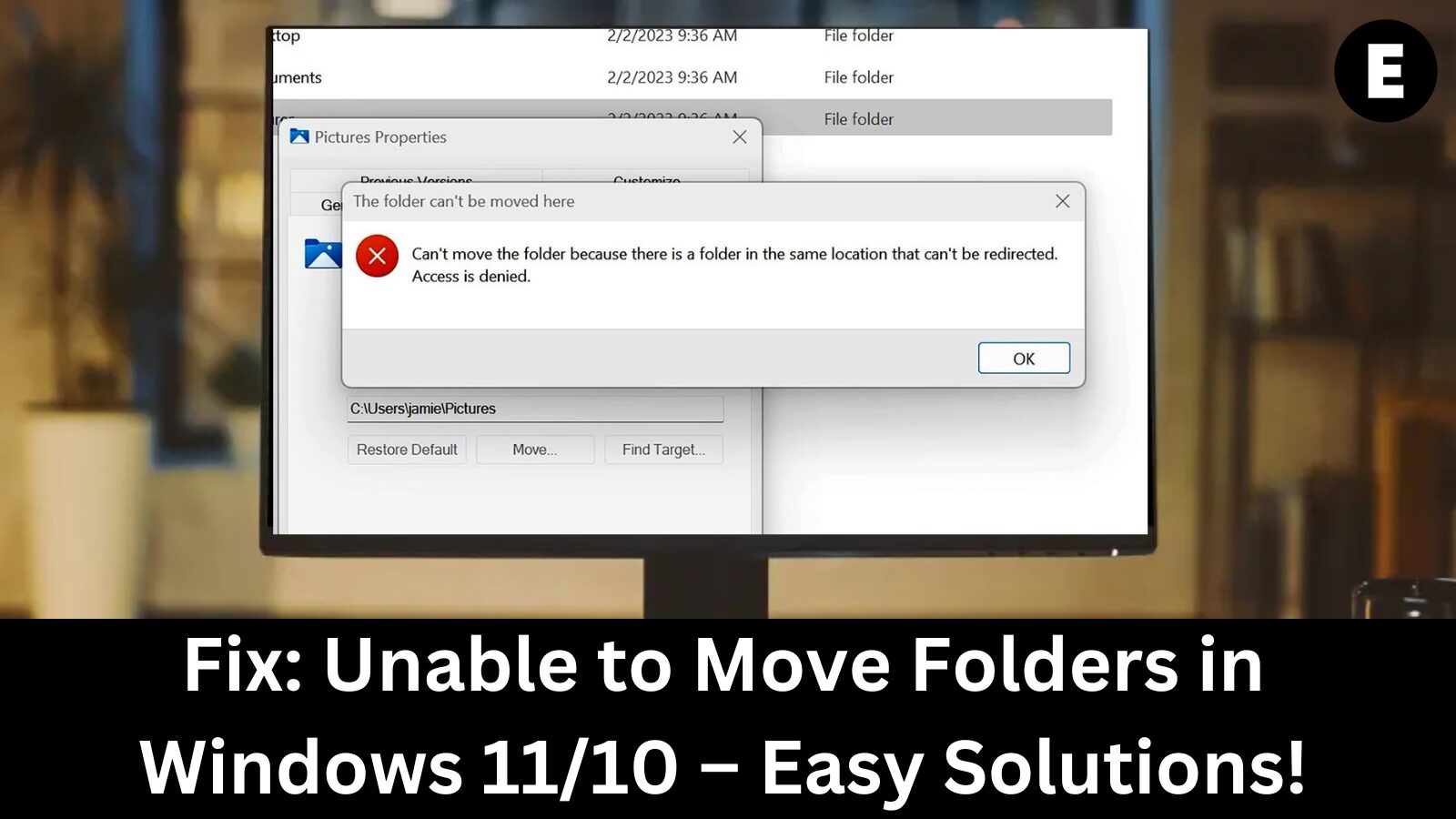If you’re a Windows 11/10 user struggling to move a folder, you’re not alone! This issue can arise due to various reasons, including a corrupted file system, malware infection, or faulty applications.
In this guide, we’ll walk you through step-by-step solutions to fix the problem, ensuring you can move folders smoothly without errors. Follow these quick and effective troubleshooting methods to regain control over your files in Windows 11/10 effortlessly!
Why Can’t You Move a Folder in Windows 11/10? Common Causes & Fixes
Before jumping into solutions, let’s understand the possible reasons why you’re unable to move a folder in Windows 11/10.
1. Folder in Use by Another Program
If you receive the error message “The action can’t be completed because the folder is open in another program,” it means an app or process is using the folder. Close the program and try again.
2. OneDrive Syncing Issues
If your folder is stored in OneDrive, syncing problems due to poor internet connection, OneDrive server issues, or network settings could prevent you from moving it.
3. Corrupt System Files
Windows relies on system files to function properly. Corrupt or missing system files due to malware, power outages, or hardware failures can interfere with file operations.
4. Incorrect File Mapping
Improper file mapping settings or conflicts with installed software may block folder movement. Resetting file mappings can resolve the issue.
5. Lack of Access Permissions
If you lack the necessary administrator or user permissions, Windows may restrict you from moving certain folders. Adjusting folder permissions can fix this.
6. Large File Size or Folder Content
Moving large files or folders requires significant system resources. If the file is too large, Windows may struggle to process the request, leading to errors.
7. Software Conflicts
Third-party apps, antivirus software, or even Windows updates can sometimes cause conflicts, preventing you from moving folders.
These are some of the most common causes behind this issue. Now, let’s explore effective fixes to help you move your folders without hassle! 🚀
How to Fix “Can’t Move Folder” Issue on Windows 11/10
Now that we’ve identified the causes behind this issue, let’s explore effective solutions to move your folders without errors.
1. Close Any Program Using the Folder
If you see the error “The action can’t be completed because the folder is open in another program,” an app or process is using the folder.
✅ Solution:
- Close any programs that might have the folder open.
- If you’re unsure which app is using it, restart your computer and try again.
2. Restore the Folder’s Default Path
Incorrect folder mapping can cause issues. Restoring the default location can fix the problem.
✅ How to Restore the Default Path:
- Right-click on the folder and select Properties.
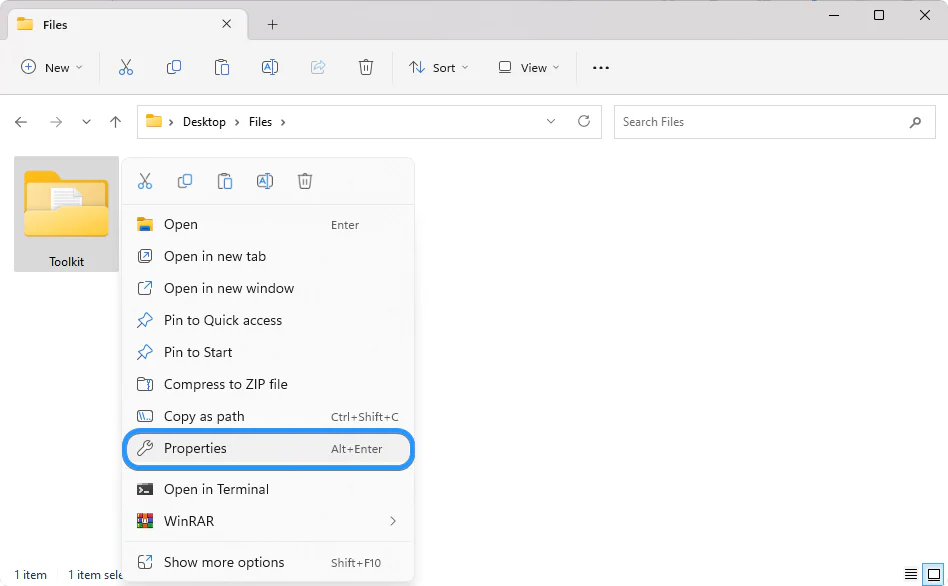
- Go to the Location tab.
- Click on Restore Default to reset the folder’s path.

- Click Apply and then OK.
- Ensure all files from the old location are copied to the new one.
This should help you move the folder without any errors! 🚀
3. Change Your OneDrive Settings
If syncing issues with OneDrive are causing the problem, adjusting the settings can help resolve it. This may involve disabling certain settings or modifying the sync frequency. Follow these steps to check and update your OneDrive settings:
- Click on the OneDrive icon in the system tray (bottom-right corner).
- Open the OneDrive app and click on the gear icon in the top-right.
- Select Settings > Account and click on Choose folders.
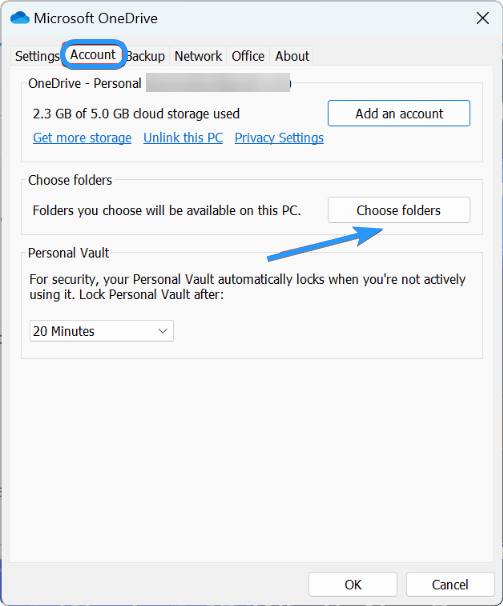
- Find “Files not in a folder” and untick it.
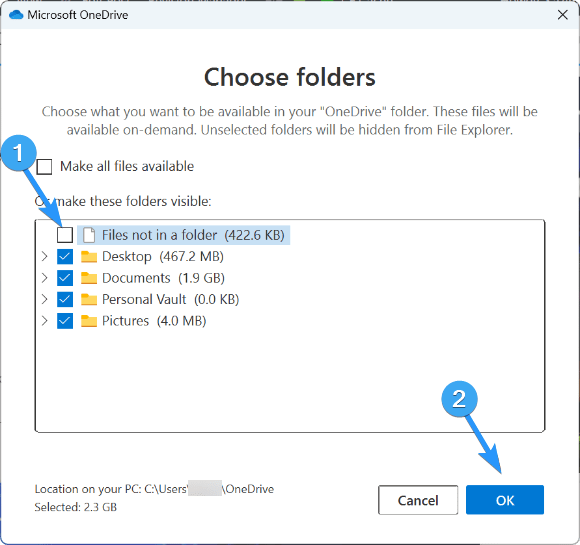
- Click OK to save changes and retry moving the folder.
After making these adjustments, try moving the folder again to check if the issue has been resolved. Disabling unnecessary OneDrive syncing options can often fix folder movement problems caused by sync conflicts.
4. Run the DISM Scan
DISM, which stands for Deployment Image Servicing and Management, is a built-in Windows tool designed to fix corrupted system files. Running a DISM scan can repair any underlying system issues that may be preventing you from moving a folder. Follow these steps to run the scan:
- Open the search bar in your taskbar by clicking on the magnifying glass icon. Alternatively, press Windows + S on your keyboard to bring up the search function.
- Type “cmd” in the search box. When “Command Prompt” appears in the search results, right-click on it and select “Run as Administrator” from the context menu. This will ensure the scan has the necessary permissions to make system changes.
- Run the DISM scan by typing the following command into the Command Prompt and pressing Enter:
DISM.exe /Online /Cleanup-image /ScanhealthThis command will scan your system for any corruption and attempt to repair any errors it finds.
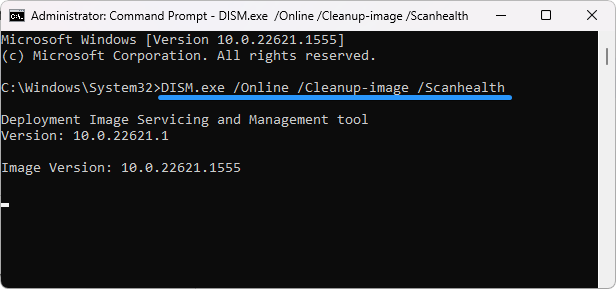
- Wait for the scan to complete. The process may take several minutes, depending on the health of your system files.
- Once the scan finishes, check if you can move the folder. If the issue persists, you may need to restart your computer and try again.
Running a DISM scan is an effective way to fix system file corruption that may be causing problems with moving folders in Windows 11/10.
5. Modify the Windows Registry to Fix Folder Movement Issues
Editing the Windows Registry can sometimes resolve issues preventing you from moving a folder. However, be cautious—making incorrect changes in the Registry Editor can cause system instability. Only proceed if you’re comfortable making registry modifications.
Step 1: Open the Windows Registry Editor
- Press
Windows + Ron your keyboard to open the Run dialog box. - Type
regeditand click OK. This will launch the Registry Editor.

Step 2: Navigate to the User Shell Folders Key
- In the Registry Editor, go to the following location:
HKEY_CURRENT_USER\Software\Microsoft\Windows\CurrentVersion\Explorer\User Shell Folders
- Once you’re in the User Shell Folders directory, locate the registry key associated with the folder you cannot move.
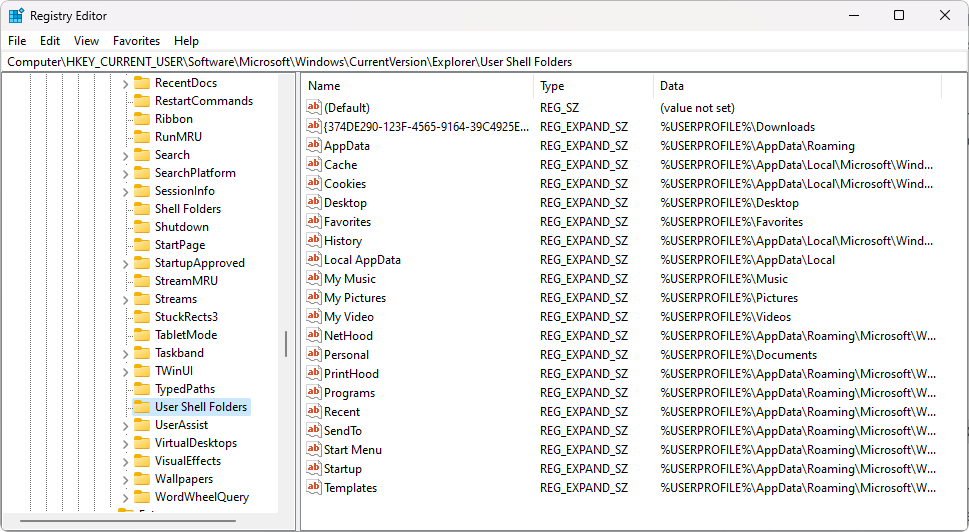
Step 3: Modify the Registry Key for the Folder
Each default folder in Windows has a corresponding Registry Value. Locate the one that matches the problematic folder and set its “Value data” to the correct system path. Use the following list for reference:
- Desktop →
%USERPROFILE%\Desktop - Favorites →
%USERPROFILE%\Favorites - Music →
%USERPROFILE%\Music - Pictures →
%USERPROFILE%\Pictures - Videos →
%USERPROFILE%\Videos - Documents →
%USERPROFILE%\Documents - Downloads →
%USERPROFILE%\Downloads
- Double-click on the registry entry for the affected folder.
- Replace the existing Value data with the correct system path from the list above.
- Click OK to save the changes.
Step 4: Restart Windows Explorer
- Press
Ctrl + Shift + Escto open Task Manager. - Locate Windows Explorer in the list of running processes.
- Right-click on Windows Explorer and select Restart.
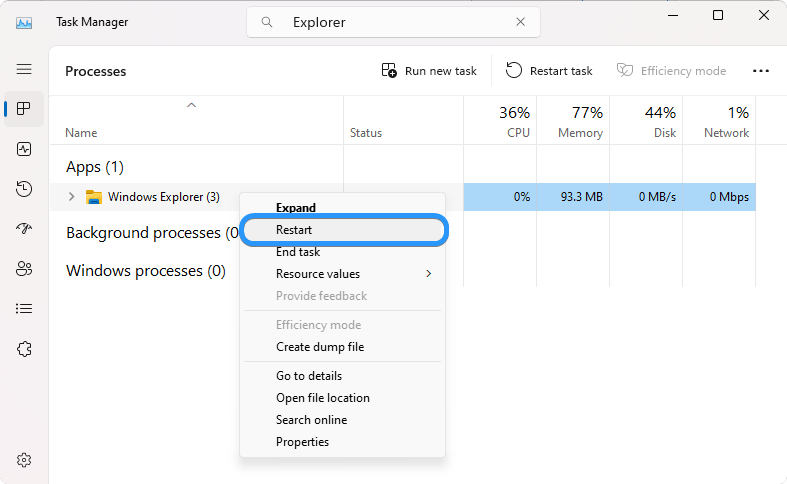
After restarting Windows Explorer, check if you’re now able to move the folder. If the issue persists, restart your computer and try again.
6. Relink Your OneDrive Account to Fix Folder Movement Issues
If you’re experiencing syncing issues with OneDrive, relinking your account can help resolve the problem. This process involves signing out of OneDrive and then signing back in, ensuring a fresh connection between your PC and OneDrive’s servers.
Step 1: Open OneDrive Settings
- Locate the OneDrive icon in your Taskbar (bottom-right corner of the screen).
- Click on the gear icon at the top-right corner of the OneDrive window.
- From the dropdown menu, select “Settings.”
Step 2: Unlink Your PC from OneDrive
- In the Settings window, navigate to the “Account” tab.
- Click on the “Unlink this PC” option.
- Follow the on-screen instructions to complete the unlinking process.
Step 3: Restart Your Device & Relink OneDrive
- Close OneDrive completely. You can do this by right-clicking the OneDrive icon in the Taskbar and selecting “Close OneDrive.”
- Restart your computer to apply the changes.
- After restarting, open OneDrive and sign in again with your account credentials.
- Follow the setup process and allow OneDrive to sync your files properly.
This method ensures that OneDrive re-establishes a proper connection, which may help resolve any folder movement issues related to syncing problems.
7. Run the System File Checker (SFC Scan) to Repair System Issues
The System File Checker (SFC scan) is a built-in Windows tool designed to detect and repair corrupted system files. Running this scan can fix file integrity issues that may be preventing you from moving folders in Windows 11/10.
Step 1: Open Command Prompt as Administrator
- Click on the magnifying glass icon in your Taskbar to open the Windows Search bar.
- Press
Windows + Sas a shortcut to access the search. - Type “cmd” in the search box.
- When you see Command Prompt in the results, right-click on it and select “Run as Administrator.”
Step 2: Run the SFC Command
- Once the Command Prompt window opens, type the following command and press Enter:
sfc /scannow - The SFC scan will begin checking your system files for corruption or missing files.
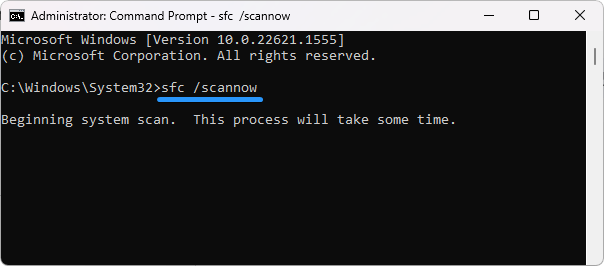
Step 3: Wait for the Scan to Complete
- The scanning process may take several minutes, depending on the speed of your computer.
- If corrupt system files are detected, the tool will automatically attempt to repair them.
Step 4: Restart Your Computer
- Once the scan completes, restart your device to apply the fixes.
- After rebooting, check if you can move folders without any issues.
Running an SFC scan is a quick and effective way to resolve system-related errors that might be interfering with file movement on your Windows PC.
One more thing
If you’re in search of a software company that embodies integrity and upholds honest business practices, your quest ends here at Ecomkeys.com. As a Microsoft Certified Partner, we prioritize the trust and satisfaction of our customers. Our commitment to delivering reliable software products is unwavering, and our dedication to your experience extends far beyond the point of sale. At Ecomkeys.com, we provide a comprehensive 360-degree support system that accompanies you throughout your software journey. Your trust is our foundation, and we’re here to ensure that every interaction with us is a positive and trustworthy one.

